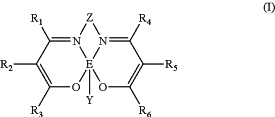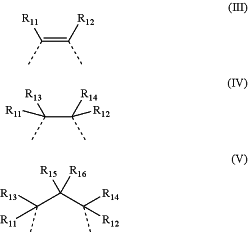| CPC C08G 64/34 (2013.01) [B01J 31/0268 (2013.01); B01J 31/2243 (2013.01); B01J 31/34 (2013.01)] | 1 Claim |
|
1. A process for preparing polycarbonate comprising copolymerizing an epoxy compound and carbon dioxide (CO2) in the presence of a catalytic system comprising:
at least one catalyst selected from complexes of a transition metal having general formula (I):
 wherein:
E represents a metal atom selected from the group consisting of chromium, manganese, iron, cobalt, nickel, and aluminum;
R1, R2, R3, R4, R5 and R6, identical or different, represent a hydrogen atom or are selected from the group consisting of linear or branched, saturated or unsaturated, C1-C20 alkyl groups, optionally containing heteroatoms; optionally substituted aryl groups; optionally substituted heteroaryl groups; optionally substituted cycloalkyl groups; and optionally substituted heterocyclic groups;
or R2 and R3 and/or R5 and R6, may optionally be linked together to form, together with the other atoms to which they are linked, a saturated, unsaturated or aromatic cycle containing from 1 to 12 carbon atoms, which may optionally be substituted with linear or branched, saturated or unsaturated, C1-C20 alkyl groups, optionally containing heteroatoms, optionally substituted aryl groups, optionally substituted heteroaryl groups, optionally substituted cycloalkyl groups, optionally substituted heterocyclic groups, trialkyl- or triarylsilyl groups, dialkyl- or diaryl-amine groups, dialkyl- or diaryl-phosphine groups, linear or branched, saturated or unsaturated C1-C20 alkoxy groups, optionally substituted aryloxy groups, optionally substituted thioalkoxy or thioaryloxy groups, and cyano groups, said cycle optionally containing heteroatoms selected from the group consisting of oxygen, sulfur, nitrogen, silicon, phosphorus, selenium, oxygen, and nitrogen;
Y represents a halogen anion selected from the group consisting of a fluoride anion, a chloride anion, a bromide anion, and an iodide anion an inorganic anion selected from the group consisting of an azide anion, a hydroxide anion, an amide anion, a perchlorate anion, a chlorate anion, a sulfate anion, a phosphate anion, and a nitrate anion or an organic anion selected from the group consisting of a C1-C20 alcoholate anion, a C1-C20 thioalcoholate anion, a C1-C30 carboxylate anion, and a C1-C30 alkyl- or dialkyl-amide anion;
Z represents a divalent organic radical having general formula (III), (IV) or (V):
 wherein:
R11, R12, R13, R14, R15 and R16, identical or different, represent a hydrogen atom; or are selected from the group consisting of linear or branched, saturated or unsaturated C1-C20 alkyl groups, optionally containing heteroatoms; optionally substituted aryl groups; optionally substituted heteroaryl groups; optionally substituted cycloalkyl groups; and optionally substituted heterocyclic groups;
or R11 and R12 in general formula (III) or in general formula (IV), or R11 and R13 in general formula (IV), or R11 and R15 or R11 and R16 in general formula (V), may optionally be linked together to form together with the other atoms to which they are linked, a saturated, unsaturated or aromatic cycle containing from 1 to 12 carbon atoms, which may optionally be substituted with linear or branched, saturated or unsaturated, C1-C20 alkyl groups optionally containing heteroatoms, optionally substituted aryl groups, optionally substituted heteroaryl groups, optionally substituted cycloalkyl groups, optionally substituted heterocyclic groups, trialkyl- or trialyl-silyl groups, dialkyl or diaryl-amine groups, dialkyl- or diaryl-phosphine groups, linear or branched, saturated or unsaturated, C1-C20 alkoxyl groups, optionally substituted aryloxy groups, optionally substituted thioalkoxy or thioaryloxy groups, cyano groups, said cycle optionally containing heteroatoms selected from the group consisting of oxygen, sulfur, nitrogen, silicon, phosphorous, and selenium;
at least one co-catalyst,
wherein the at least one co-catalyst is triphenyl(4-pyridinylmethyl)phosphonium chloride hydrochloride (UHFFA).
|